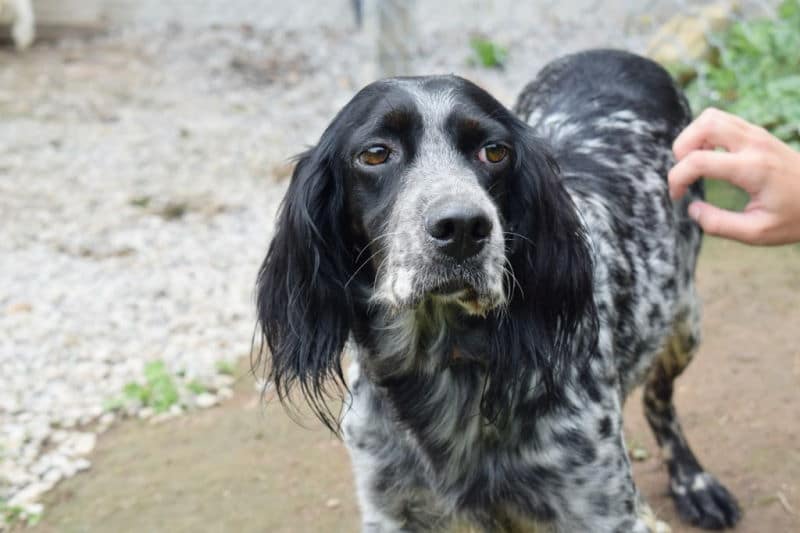

The Argentine Tegu is a large reptile popular among reptile owners in North America. They are quite exotic, but their size makes them more inconvenient to own and care for than other smaller reptiles.
The Argentine Black and White Tegu is also known as the Argentine Giant. These not-so-little lizards can be up to 4.5 feet long and weigh 20 pounds. As their name indicates, they are primarily black and white.
Due to the size of these lizards, there are plenty of people that consider them to be dangerous. However, these reptiles are surprisingly docile and can even become companion pets over time.
Quick Facts About the Argentine Black and White Tegu
| Species Name: | Salvator merianae |
| Common Name: | Argentine Black and White Tegu |
| Care Level: | Moderate to high |
| Lifespan: | 15-20 years |
| Adult Size: | 3-5 feet long and 20 pounds |
| Diet: | Insects, fruit, and lean meat |
| Minimum Tank Size: | 8x4x4 feet |
| Temperature & Humidity | 75-85 degrees Fahrenheit and between 75-90% humidity |
Do Argentine Black and White Tegus Make Good Pets?
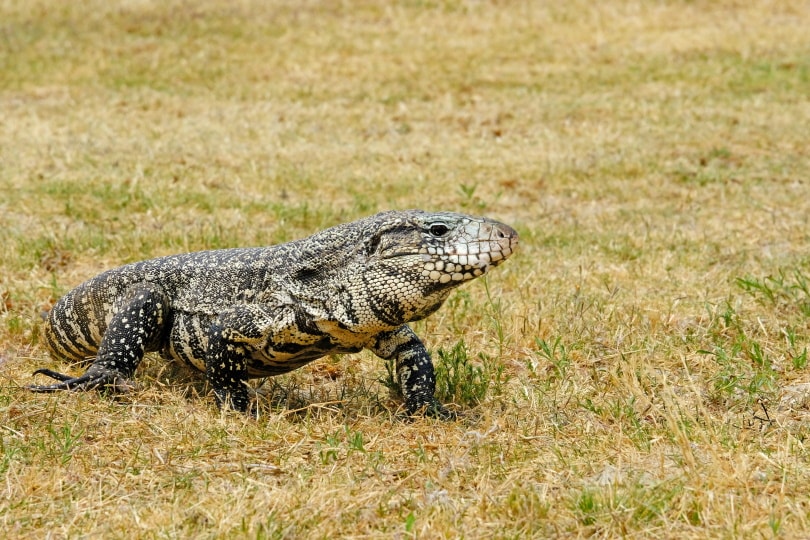
Argentine Black and White Tegus are exotic animals that can run quickly with their powerful legs and stocky tails. They are from eastern and central South America. Although they are most associated with Argentina, they span throughout Uruguay, Paraguay, and several other surrounding countries.
These reptiles are surprisingly relatable and easy to handle. In addition, they have a reputation for developing close relationships with their owners. This and their ease of husbandry make them quite popular.
Appearance
The Black and White Tegu is just that: black and white. These animals hatch at about 7 to 10 inches long. However, they tend to grow quickly from there, reaching about 75% of their adult length within 1 year. The males tend to be longer by about 1-1½ feet.
Tegus have forked tongues that they use to help them “smell” the air and determine if there are any predators or prey around them.
The skin pattern of the Black and White Tegu is what sets them apart more than anything else. They are covered in bands and strips of black and white coloring.
When they first hatch, they can have green on their heads that extends down to their necks. As they age, the color fades and joins in with the rest of their body’s black-and-white pattern.
Tegus like this can also come in red. However, these are called Red Tegus and are slightly smaller than the Argentine Black and White.
How to Take Care of the Argentine Black and White Tegu
Habitat, Tank Conditions & Setup
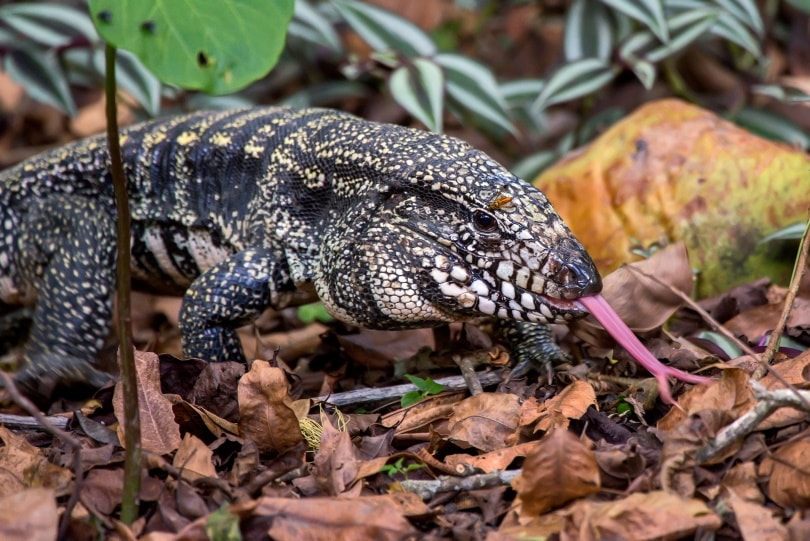
Tank
Argentine Tegus are large, so they need a tank that will fit them by size and enable them to move around freely. The best enclosures for these large lizards are often made with melamine and a glass window that allows you to see inside.
You can use smaller terrariums for the lizard when they are a hatchling. Since they grow so fast, though, you will need to be ready within the 1st year to rehouse them in their large, adult-sized enclosure.
You can house a hatchling in a 20-gallon terrarium and juveniles in an 80-gallon terrarium. However, since these lizards are active, they will decline in health quite quickly without enough space.
Lighting
These lizards come from warm, tropical areas and won’t survive if they are kept in cold or even cool enclosures for too long. You should use a UVB light to help them get the nutrients and glow that they would get from the sun. Often, terrarium hoods support this kind of lighting because it is so commonly needed.
Heating (Temperature & Humidity)
Not only do these lizards need plenty of space and a specialized light to stay happy and healthy, but you also need to provide them with a hot basking spot.
The spot should be between 100 and 110 degrees Fahrenheit and should always be available to them. This is because they will spend large swaths of time there. You can achieve this kind of spot by using red heat bulbs.
In the rest of their enclosure, keep the temperature at around 75 to 80 degrees Fahrenheit.
Substrate
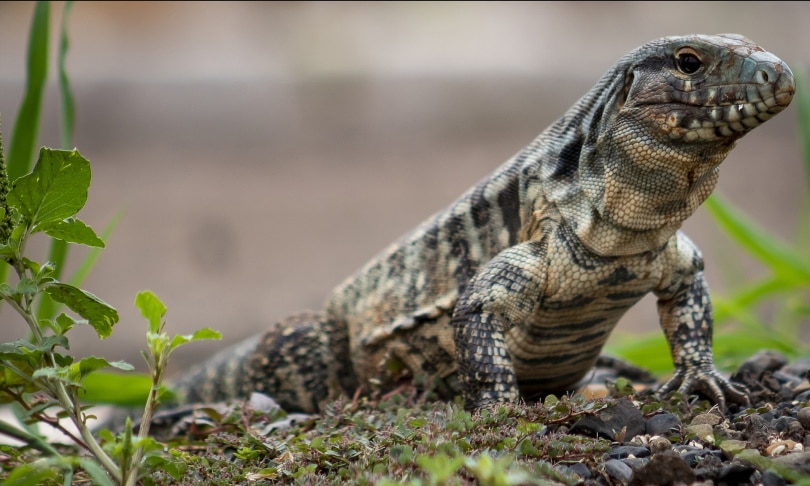
The substrate is another essential part of a Tegu’s enclosure. Tegus love to burrow and need to live in a tank with plenty of substrate. You can use things like coconut coir, cypress mulch, soil, and sand. These also help maintain the high humidity that these animals need.
Adults need about 8 inches of the substrate to burrow into effectively. Avoid anything dusty or resinous. Many of these will be toxic to your Tegu and cause them lasting and even fatal harm.
| Tank Recommendations | |
| Tank Type | 8x4x4 foot minimum enclosure, melamine and glass |
| Lighting | UVB light |
| Heating | Red heat bulbs, heat pads, ceramic heat emitters |
| Best Substrate | Soil, coconut coir, cypress mulch, sand |
Feeding Your Argentine Black and White Tegu
As with any pet, feeding them a balanced diet will help them stay healthy and happy for a long time. Tegus are called “opportunistic omnivores.” That means they will eat whatever is around them and available. That includes things like meat, fruits, insects, and plant matter.
Your Tegu’s diet should be a healthy mix of all these things, although heavier on the protein side. Feed adult tegus plenty of lean meat sources, like egg, fish, or frozen rodents. You can feed baby Tegus insects dusted in calcium.
You can also feed Tegus certain kinds of fruits and vegetables. Always check their calcium ratio, though, because they need plenty of it to function properly.
You should also ensure that your Tegu always has fresh and clean water. They will often look for somewhere to soak when they get hot or when they need to shed. Having a larger water container will help with this.
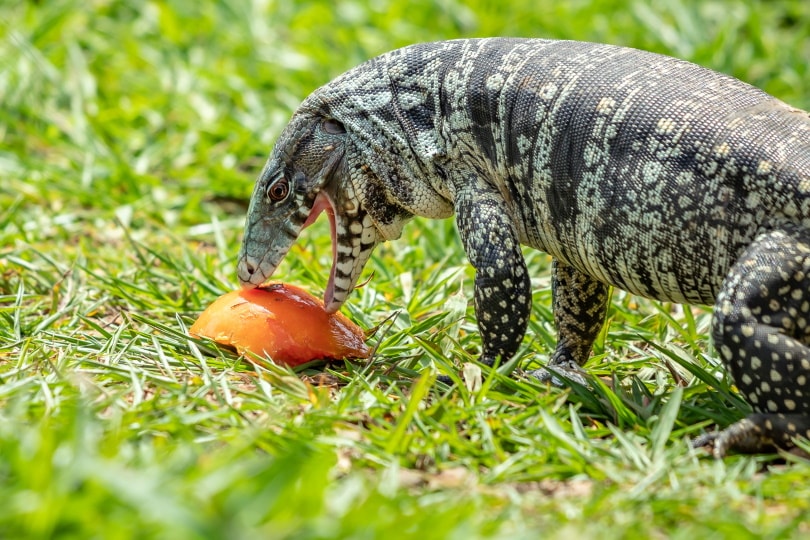
| Diet Summary | |
| Fruits | 30% of diet |
| Insects | 10% of diet |
| Meat | 60% of diet |
| Supplements Required | Calcium |
Keeping Your Argentine Black and White Tegu Healthy
Even though Tegus can be docile and can even come to enjoy spending time with you outside of their enclosure, you still need to take precautions to keep both you and them healthy.
Tegus can harbor dangerous bacteria like salmonella, so you should always wash your hands before and after handling them. Don’t let them anywhere near your kitchen utensils or food.
It might take a while for your Argentine Tegu to become comfortable with you, so try to take your time. Introduce handling in steps so they learn to trust you. They will also be more aggressive around their food, so we recommend not handling them when you have to put food in their tank.
One positive thing is that Tegus are not likely to bite unless they are backed into a corner. They will often prefer to run away.
Common Health Issues
- Metabolic bone disease
- Calcium deficiency
- Phosphorus deficiency
- Internal parasites
- Salmonella poisoning
Lifespan
In captivity, Black and White Tegus typically live between 15 to 20 years. That means you must commit when you adopt one.
As long as they don’t suffer from a calcium deficiency and they have a proper enclosure, they are likely to live their whole lifespan.
Are Argentine Black and White Tegus Friendly? Our Handling Advice
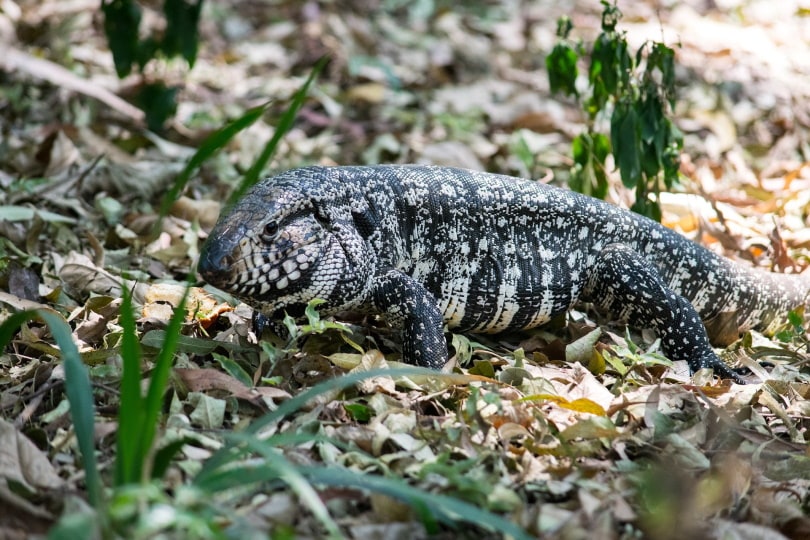
Black and White Tegus can be quite docile and friendly. They take a while to warm up to their owner, but as long as they feel comfortable around you, they will be friendly. After a while, they will start to come to you when you stick your hand in their enclosure.
We recommend that you start handling your Tegu as early as possible, since getting an adult to trust you can be much more difficult. Instead, get a hatchling to be comfortable around you.
Tegus have a strong fight-or-flight tendency when they aren’t expecting you to be around. You should also never feed them when they are trying to eat. During these times, they are likely to be uncharacteristically aggressive.
Shedding & Brumation: What to Expect
Tegus tend to brumate when the colder weather of their natural habitat would typically start to kick in. Even if you haven’t adjusted their tank temperature in those cooler months, they will begin to get more lethargic and become less active.
This behavior is normal and means that they are living a healthy annual life cycle. They won’t go into quite as deep of a brumation as other reptiles. Instead, they will often just spend a great part of the day asleep. They will still eat a little and bask in their hot area.
As for shedding, as long as you keep your lizard’s tank at the appropriate humidity levels, they should be able to shed their skin easily. You might want to provide them with a tub of water large enough for them to soak in, though. Just make sure it doesn’t go past your Tegu’s shoulders, and don’t leave them unattended with it.
How Much Do Argentine Black and White Tegus Cost?
Argentine Tegus from a breeder will often cost around $200 for a hatchling. You will often need to find a reputable breeder because these reptiles are not typical to find in a pet store.
Care Guide Summary
Argentine Tegu Pros
- Docile nature
- Inquisitive and exploratory
- Simple diet
Argentine Tegu Cons
- Must be housed individually
- Large
- Moves during handling

Conclusion
Argentinian Tegus might look aggressive, but you don’t have to be afraid of these typically gentle and docile creatures. The best way to care for them and get them comfortable with you is to provide them with plenty of space, a balanced diet, and an enclosure that emulates their natural environment.
Your Tegu will need plenty of love from you, particularly once they become comfortable with you. As long as you are willing to put in the effort, having a Tegu as a companion will be rewarding.
Featred Image Credit: dwi putra stock, Shutterstock
Ed Malaker is a veteran writer who has contributed to a wide range of blogs that cover tools, pets, guitars, fitness, and computer programming. When he’s not writing, Ed is usually performing DIY projects around the house or working in the garden. He’s also a musician and spends a lot of time helping people fix their guitars and composing music for independent films.

